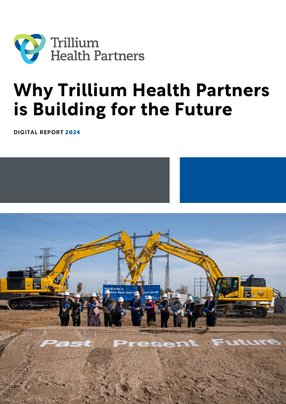Trillium Health Partners (THP) is a leading hospital in the Mississauga region in Ontario, Canada, and it serves a diverse population. Diverse, and ageing – for like most health care providers in the developed world, THP is having to cater for an increasing number of people living with chronic diseases.
Credit Valley Hospital is a regional leader in specialised programs for clinical genetics, renal, maternal-child care and oncology, as well as core clinical programs in general medicine, surgery, emergency, mental health, rehabilitation, obstetrics and gynaecology, paediatrics and cardiac services.
All told, THP offers around 1,457 beds, making it the largest community hospital in Canada. Yet the population is growing and it currently experiences more than 214,000 emergency visits a year. To keep pace with the growing community, THP needs to use an innovative approach and build a new kind of health care for a healthier community,
Skerdi Cerga is Chief Technology Officer of THP,
and says the growing demands on its services is precisely why the organisation cannot stand still.
“We must take into account inevitable changes on the horizon,” he says. “To continue delivering exceptional patient care we need an innovative approach to the delivery of health care.”
This need has given rise to what THP calls an ‘interconnected system of care’, which is is organised around patients “both inside the hospital and beyond its walls”, explains Skerdi, who adds: “It is by working in a coordinated way across the system that we will meet the needs of our patients, and continue to provide outstanding, sustainable quality patient care.”
Peter Gilgan Mississauga Hospital will be state of the art
To this end, THP is planning to build a new kind of health care that will be equipped to serve its growing and diverse community for decades to come.
The Peter Gilgan Mississauga Hospital will be a full replacement of the existing hospital and, says Skerdi, “will redefine a new urban centre focused on health in this part of the city”.
In addition to the 350 beds extension at Queensway Health Centre, the new 22-storey hospital will offer more than 950 beds and be almost triple the size of the current building. There will be 23 operating theatres – nine more than at present – and all patients will also have private rooms.
Plus, it will house one of the largest emergency departments in the province, reducing wait times and improving patient experience.
The new hospital will also include advanced diagnostic imaging facilities and a new pharmacy and clinical laboratory.
In short, The Peter Gilgan Mississauga Hospital will allow THP to respond better to future health care challenges, to offer modern facilities and technology, and help it continue delivering highly specialised care through its regional programs, which include a centre for cancer care, and others for advanced cardiac surgery and geriatric mental health services.
Skerdi explains that THP’s extensive community health programme is designed to create a healthier population, “because this means less pressure on the hospital”.
He adds: “We work very closely with our communities, even offering at-home monitoring and medical alert services. Having that end-to-end visibility, from people’s homes, from the hospital, to long-term care and back to the hospital, we are like a health care hub, run from a centralised location.”
But he adds that offering such varied, expansive, vital and inter-connected services makes for an extremely complex IT environment.
“You have 27,000 different pieces of equipment running on either IoT, OT, or biomedical networks, and some of these are legacy, and that for various reasons cannot easily be replaced.”
He says that with equipment often costing tens of millions of dollars, replacing or refreshing hardware whenever technology moves on is simply not possible.
How THP meets health care technology challenges
“IT moves in short cycles of between three and five years, so that's one of the biggest challenges,” he says. “With equipment in a medical environment you have to make sure everything is secure, always available and always accessible, so that it can meet the requirements of our clinical teams.”
Overcoming the challenges of legacy equipment comes down to always being on top of new developments, says Skerdi.
“You have to always stay updated on the technology,” he explains. “You need to have vision and understanding, and know what this means for your role and for your portfolio. Plus you need to know how this aligns with the mission and objectives of the organisation.”
This, says Skerdi, is why he and his team have to know how to prioritise.
“It’s impossible to boil the ocean in one day. You have to know how to prioritise, what to prioritise, and when to execute. This is critical for me to be successful in my role.
Skerdi learned this lesson the hard way, in a previous role, also in health care.
“I joined THP from a cancer care organisation, where I tried to do a lot of things at the same time,” he says. “My boss at the time advised me to focus on one thing – to prioritise, and complete a task, before moving on to the next one.
“If you make the foundation strong you can build anything on top of it but if you try to do too many things, the foundation is weak, and it’s just a matter of time before it crumbles.”
As well as equipment-related challenges, Skerdi also has to stay on top of complex and ever-changing government regulations around health care risk and compliance.
“We need to know what we can and cannot do,” he says. An example is data residency.”
The example he cites is protected health information (PHI) data.
“We cannot move PHI data outside of Canadian borders, and ensuring that we comply with this is part of our processes,” Skerdi says, and adds that implementing changes while maintaining safeguards around PHI data is vital.
“The Cloud has opened our horizons significantly but you always need to be aware of what we can do and cannot do. Not everything can and should go to the Cloud, and we have built criteria around this.”
Not all health care solutions can go in the Cloud
As an example of what should, and shouldn’t, go on the Cloud, Skerdi references large data-sets that need to be “transitioned both ways”.
“For data that needs to be pushed out and pulled back in, the Cloud is not always the best solution.”
A case in point, he says, is THP’s picture archiving and retrieving solution, which involves 2.5 billion files.
Skerdi adds that “digital pathology is the next big one”, and that he and his team are planning a solution around this that will contain files amounting to a colossal two petabytes or more (a petabyte is equal to 1,000 Terabytes). And that’s just the first tier of data.
“These solutions might not be ideal for the Cloud,” he says. “These will need to be on-premises or hybrid.”
Helping THP plot its course into a technology-driven future is one of its key partners, TechniCore, which provides expertise in clinical engineering services to support medical equipment and facilities.
“We’re working with TechniCore to build our technology roadmap,” says Skerdi. “Looking to the future is very important. We’re looking at what the clinical needs are and how those will translate to the implemented technology.”
He adds that THP must also assess how the technology will integrate with existing solutions, and also how it will migrate from legacy systems, plus where it can refresh hardware where possible.
“We need to know if there will be any downtime, and how this will impact our clinical services,” he says. “Hence we need the expertise and knowledge that an implementer like TechniCore brings to the table.
Skerdi adds: “And it's not a seller-buyer relationship. It’s a relationship built on trust. If we have an issue we know we can reach out to them to help and get a response in a very short time.”
Although Skerdi’s time is consumed with complex IT challenges, he never loses sight of what it is all for – especially at the end of the day, as he winds through the hospital on his way home.
“When I see patients and their families smiling and being happy, even though they are in a hospital, it reminds me I'm making an impact on everyday life for 1.2 million people, and this gives me enormous satisfaction. I can’t think of another job in IT that can do this.”
**************
Make sure you check out the latest industry news and insights at Healthcare Digital and also sign up to our global conference series - Tech & AI LIVE 2024
**************
Healthcare Digital is a BizClik brand






